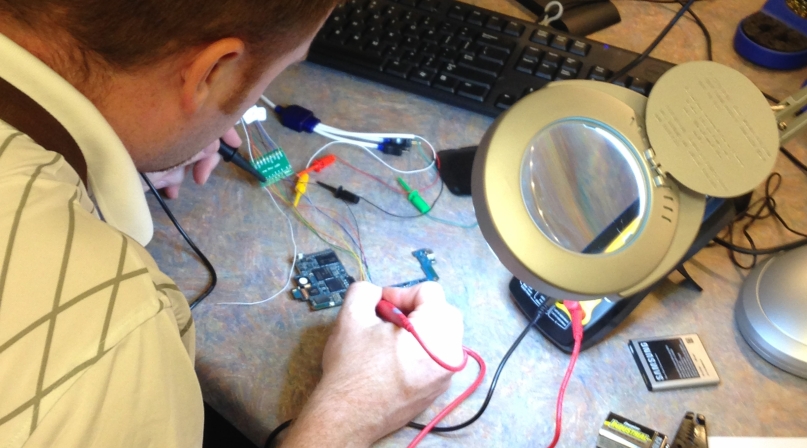Bright Ideas - Aug. 22, 2016
Upcoming Events
Related News

Electronic Crimes Unit Targets Domestic Violence
Problem: Dakota County, Minn. and its cities had inadequate resources to solve a growing number of crimes involving digital devices.
Solution: A county-led electronic crimes task force whose synergies multiplied available staff and expertise.
Det. Ryan Olson, Dakota County, Minn. Sheriff’s Office, extracts data from an electronic device. Photo courtesy of Dakota County, Minn.
About two years before the Dakota County, Minn. Sheriff’s Office created an electronic crimes task force, a local homicide helped make the case for more staff and equipment to fight cybercrimes.
“We had one situation where a guy pushed his pregnant wife down the stairs,” Sheriff Tim Leslie recalled.
“The day before, he’s at his phone Googling ‘can you die from falling down the stairs,’” authorities discovered after the fact by sifting through data from his cellphone and computer.
The husband had also tried to create an alibi by texting himself a message from his dead wife’s phone — posing as her asking him to pick up some carryout food while he was “out.” He was subsequently found guilty of murdering his wife and unborn child.
It all happened in Apple Valley, one of nine cities within the county that have partnered with the Dakota County Sheriff’s Office to form an Electronic Crimes Task Force.
The idea began to take shape in 2013, when Leslie was preparing a $35,000 budget for new equipment for what was, at the time, a computer crimes unit staffed by 1.5 full-time equivalents.
“They were falling terribly behind, so we hired a civilian part-time, one-day-a-week forensic analyst,” said Leslie, who was chief deputy at the time.
He wondered whether the cities that had their own, small electronic crime units were facing the same kinds of costs. Sheriff’s officials and city police chiefs had a meeting on the topic in November of that year.
They found they had similar challenges: aging computer systems needing frequent upgrades, varying levels of expertise among staff, work backlogs when personnel are on vacation or at training, keeping up with new technologies, personnel burnout and lack of specialization among staff assigned.
That’s when they decided to pool resources. The task force was formed through a joint powers agreement in 2014 and began its work in January 2015. In its first year, the unit handled 214 cases and analyzed 616 devices including 296 phones. The task force was recognized for innovation last year by the University of Minnesota’s Hubert Humphrey School of Public Affairs.
City law enforcement agencies contribute either funding or personnel to the effort, whose budget is about $666,000 for a three-year pilot. The task force is funded by the county, the cities of Apple Valley and Burnsville, and a $200,000 federal Violence Against Women Act (VAWA) grant. The staff comprises four sworn officers and two civilian forensics specialists.
“Part of what we do in our electronic crimes unit is we attack orders for protection, orders for harassment violations,” Leslie explained. The VAWA grant funds a staff person who focuses on domestic and dating assault, sexual assault and stalking cases.
Domestic violence victims are one of two groups that are overrepresented among electronic crime targets; the other is the elderly. Since the task force’s creation, he added, it’s been able to ferret out data on domestic abusers that’s been used to elevate stalking charges from misdemeanors to felonies. For example, cellphone data helped to document a domestic abuser’s intention to buy GPS tracking devices to hide in the victim’s car.
Once the county’s line officers learned of the unit’s capabilities and shorter turnaround times — a few days in most cases down from 60 days previously — “the submissions of cell phone and computer evidence as well as prosecutions from these cases increased,” Leslie said.
“You’re really missing the boat if you think you can do everything by yourself. I guess maybe LAPD and NYPD and those really big departments can probably do it on their own, but most of us cannot.
“And so rather than try to make your palace really big — share, collaborate, because the effectiveness is really for the citizens.”
Attachments
Related News

Congress introduces Second Chance Act reauthorization
On April 16, the Second Chance Reauthorization Act of 2024 (H.R. 8028) was introduced in the U.S. House of Representatives with robust bipartisan support. NACo supports this legislation, which would reauthorize funding for Second Chance Act (P.L. 110-199) programs for five years.

HRSA offers funds to aid care transitions for justice-involved individuals
On April 10, the U.S. Department of Health and Human Services’ Health Resources and Services Administration (HRSA) announced the availability of $51 million in funding opportunities open to HRSA-funded health centers. HRSA-funded health centers, which serve over 30 million patients, play a crucial role in county healthcare systems emphasizing equity and accessibility in healthcare. This new initiative focuses on supporting individuals leaving incarceration by providing health services during the critical 90 days before release, assisting justice-impacted individuals with their return to the community by expanding access to primary healthcare—including mental health and substance use disorder treatment.

DHS announces $1.8 billion in preparedness grants to advance county security and resilience
On April 16, the U.S. Department of Homeland Security (DHS) unveiled more than $1.8 billion in funding for eight preparedness grant programs in Fiscal Year (FY) 2024. These grants play a crucial role in helping county governments bolster their readiness and response capabilities against terrorism and disasters.